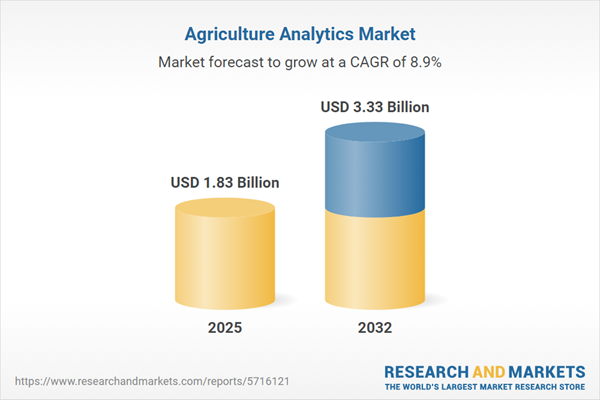Speak directly to the analyst to clarify any post sales queries you may have.
Agriculture analytics is transforming how senior agribusiness leaders make strategic choices by enabling accurate resource management, informed risk planning, and agile operations in today’s complex, data-centric environment.
Agriculture Analytics Market Snapshot
The agriculture analytics market is gaining global momentum as organizations seek to enhance value across farming and supply chains. Notably, investment in advanced analytics is helping to digitalize key processes, gather and analyze real-time data, and manage unpredictability in agricultural operations. Executive leadership now benefits from tools that anticipate demand, support compliance requirements, and enable responsive strategies, improving visibility and tactical planning. As digital platforms and automation become deeply integrated, agribusinesses are reshaping planning cycles, regulatory tracking, and business continuity, with analytics now central to long-term sector transformation.
Agriculture Analytics Market Scope & Segmentation
Market segmentation in agriculture analytics ensures platforms align with operational, regulatory, and regional requirements, supporting both immediate efficiencies and enduring transformations across the value chain. Solution offerings address strategic objectives for crops, technologies, and diverse business models.
- Crop Types: Analytics solutions are developed for specific crops, including wheat, corn, rice, barley, cotton, jute, fruits, vegetables, oilseeds, and pulses. This customization enables the precise allocation of inputs and resources, helping organizations optimize yields and supply management for each crop type.
- Technology: Platforms leverage big data analytics, predictive modeling, IoT integration, drone-based observation, and geographic information systems. Such technologies provide refined insight for field and livestock monitoring, promoting efficiency and informed decision-making throughout planting and production cycles.
- Applications: Key applications involve field monitoring, livestock management, crop mapping, and logistics intelligence. These functions enhance traceability, transparency, and sustainability across increasingly complex supply chains, supporting continuous improvement in agribusiness operations.
- Farm Size: Scalable analytics support diverse operations, including small, medium, and large farms. Platform flexibility addresses varying digital maturity and growth requirements, ensuring relevance for expanding or traditional agri-enterprises.
- End Users: The primary users include agribusinesses, individual producers, and public sector agencies, each applying analytics to manage oversight, drive efficiency, and support regulatory compliance within their organizations.
- Regions: Adoption is influenced by regional infrastructure and compliance standards, with distinct patterns emerging across The Americas, Europe, Middle East, Africa, and Asia-Pacific. Each region exhibits unique integration challenges and opportunities for digital transformation.
- Company Coverage: Industry leaders such as Deere & Company, Trimble Inc., AGCO Corporation, CNH Industrial N.V., Topcon Positioning Systems, Raven Industries, IBM, Microsoft Corporation, Oracle Corporation, and SAP SE are advancing innovation and expanding analytics-based partnerships worldwide.
Agriculture Analytics: Key Takeaways for Senior Decision-Makers
- Embedding data analytics into operations enhances resource optimization and planning, fostering organizational stability amid evolving market dynamics.
- IoT sensors and drone deployments enable granular monitoring of fields and livestock, assisting organizations in meeting sustainability and regulatory objectives while quickly adapting strategies.
- Integrated analytics platforms deliver valuable supply chain intelligence, increasing transparency and improving organizational agility to respond to market disruptions or shifting requirements.
- Collaboration among technology providers, equipment manufacturers, and logistics partners ensures analytics solutions are adaptable for unique regional environments and regulatory frameworks.
- Modern data management practices help organizations address regulatory variation, streamlining multinational operations and ensuring robust compliance measures.
- Continuous utilization of analytics provides early warning for operational risks, strengthening competitive readiness and supporting swift response to both agribusiness and climate-related challenges.
United States Tariffs in 2025: Strategic Implications
The introduction of United States tariffs in 2025 is requiring agribusinesses to reassess supply chain and trade strategies. With advanced analytics, leadership can simulate evolving trade scenarios, reinforce risk management efforts, and refine logistics plans—maintaining continuity and resilience in rapidly changing policy environments.
Research Methodology & Data Sources
This report draws on direct interviews with industry executives alongside broad-based secondary research, including regulatory assessment and benchmarking studies. Every key finding is independently validated for senior decision-makers seeking an objective understanding of agriculture analytics deployments.
Why This Agriculture Analytics Market Report Matters
- Supports alignment of executive technology investment with shifting regulatory and market conditions, leading to streamlined, data-driven decision making.
- Delivers actionable, standardized regional analysis that supports compliance, sustainability, and targeted market expansion initiatives.
- Equips organizations to achieve immediate performance improvements and positions them for ongoing innovation across farming and agri-supply chains.
Conclusion
Adoption of agriculture analytics enables organizations to maximize operational outcomes, react decisively to market shifts, and advance sustainability priorities as the sector continues to evolve.
Additional Product Information:
- Purchase of this report includes 1 year online access with quarterly updates.
- This report can be updated on request. Please contact our Customer Experience team using the Ask a Question widget on our website.
Table of Contents
3. Executive Summary
4. Market Overview
7. Cumulative Impact of Artificial Intelligence 2025
Companies Mentioned
The companies profiled in this Agriculture Analytics market report include:- Deere & Company
- Trimble Inc.
- AGCO Corporation
- CNH Industrial N.V.
- Topcon Positioning Systems, Inc.
- Raven Industries, Inc.
- International Business Machines Corporation
- Microsoft Corporation
- Oracle Corporation
- SAP SE
Table Information
| Report Attribute | Details |
|---|---|
| No. of Pages | 190 |
| Published | November 2025 |
| Forecast Period | 2025 - 2032 |
| Estimated Market Value ( USD | $ 1.83 Billion |
| Forecasted Market Value ( USD | $ 3.33 Billion |
| Compound Annual Growth Rate | 8.9% |
| Regions Covered | Global |
| No. of Companies Mentioned | 11 |









